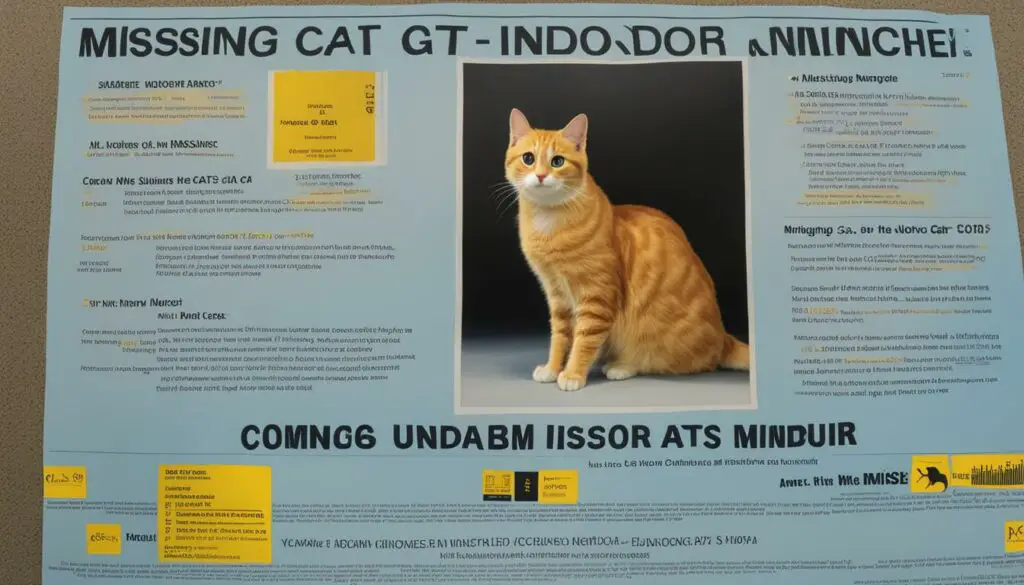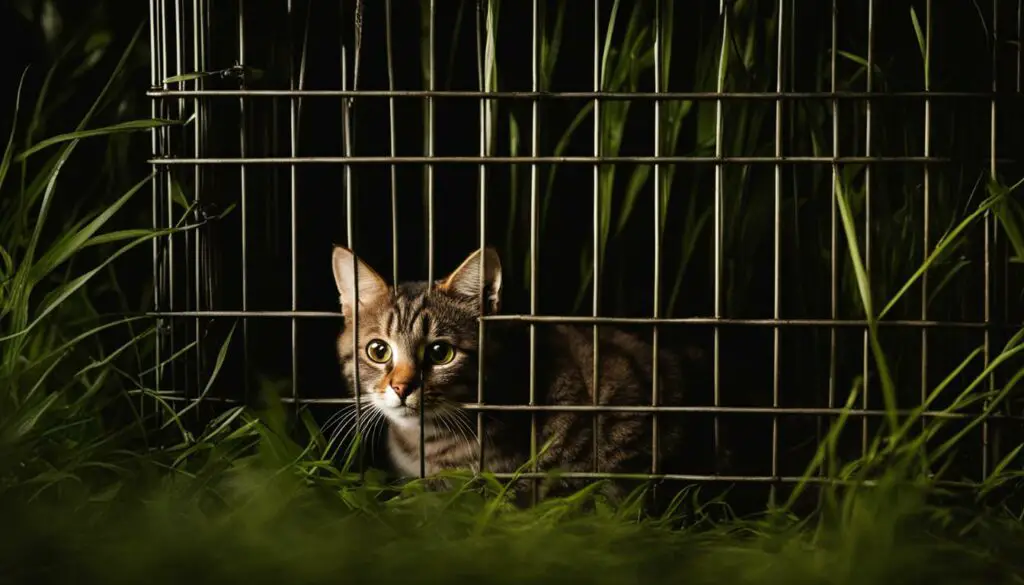If your indoor cat has been missing for 3 days, it can be a distressing and worrisome time. As a cat lover and owner myself, I understand the anxiety that comes with the uncertainty of your beloved pet’s whereabouts. However, there are steps you can take to increase the chances of bringing your furry friend back home safely.
In this article, I will provide you with expert advice and research-backed strategies on how to find your missing indoor cat. By following these tips, you can navigate through this challenging situation and improve the likelihood of a happy reunion with your beloved feline companion.
Key Takeaways:
- Conduct a thorough physical search of your immediate area
- Spread the word about your missing cat
- Utilize technology to locate your cat
- Alert authorities and microchip companies
- Utilize online search tools and resources
Conduct a Thorough Physical Search
When your indoor cat has been missing for three days, the first step in increasing the chances of finding them is to conduct a thorough physical search of your immediate area. Start by focusing on your home and property, carefully examining every nook and cranny where your cat could potentially be hiding. Enlist the help of friends and neighbors to assist in the search, as they may have a different perspective or be familiar with your cat’s usual hiding spots.
During the physical search, pay special attention to common hiding spots such as under decks, porches, garages, and sheds. Indoor cats who escape outdoors often seek out these secluded areas close to home. By thoroughly searching these locations, you may be able to locate your cat within a short distance from your residence.
Remember to remain patient and methodical during the search, carefully checking every possible hiding spot. It can be helpful to have a flashlight on hand to illuminate dark areas and to call out your cat’s name in a soft, reassuring voice. The goal is to be as thorough as possible in order to increase the chances of finding your beloved feline friend.

Tips for Conducting a Thorough Physical Search:
- Gather a group of friends and neighbors to help you search.
- Check common hiding spots such as under decks, porches, garages, and sheds.
- Use a flashlight to illuminate dark areas.
- Call out your cat’s name in a soft, reassuring voice.
- Be patient and thorough in your search.
Spread the Word
When your indoor cat goes missing, spreading the word is crucial in increasing the chances of finding them. Here are some effective ways to get the message out:
1. Knock on Doors and Hang Lost Cat Posters
One of the first steps you can take is to physically reach out to your neighbors by knocking on their doors. Inform them about your missing cat and provide a description. Additionally, hang eye-catching “lost cat” posters in your neighborhood, including a clear photo of your furry friend and your contact information. Placing these posters in highly visible areas such as community bulletin boards, local stores, and telephone poles can help increase the likelihood of someone spotting your cat and reaching out to you.
2. Utilize Social Media and Online Platforms
Social media platforms can be powerful tools for spreading the word about a missing cat. Create posts on your personal accounts and share them with your friends and family. Additionally, search for local Facebook groups dedicated to lost and found pets and join them to post about your missing cat. Include all relevant details such as your cat’s description, last seen location, and any distinctive markings. Utilize hashtags such as #lostcat and #missingpet to maximize visibility. Apart from social media, consider utilizing online platforms such as missing pet registries and local community websites to reach a wider audience.
3. Alert People and Professionals in Your Neighborhood
Inform people who regularly visit your neighborhood about your missing cat. This can include dog walkers, mail carriers, delivery drivers, and even local landscapers. They often traverse the area and can keep an eye out for your cat during their daily routines. Additionally, reach out to local animal shelters, veterinary clinics, and rescue organizations to provide them with information about your missing cat. They may be able to offer guidance, share your cat’s details with their network, or assist you in your search efforts.

| Lost Cat Poster Template |
|---|

|
Remember, the more people who are aware of your missing cat, the higher the chances of someone spotting and reporting their whereabouts. Stay proactive and persistent in spreading the word, as it can significantly contribute to bringing your beloved feline back home.
Use Technology to Locate Your Cat
When searching for a missing indoor cat, technology can be a valuable tool to help bring them home. By harnessing the power of motion-activated cameras, feeding stations, and humane traps, you can increase your chances of locating your beloved feline friend.
One effective method is to set up a motion-activated camera near a feeding station. This allows you to monitor your cat’s movements and establish their visiting patterns. Once you have a better understanding of when and where they come around, you can strategically place a humane trap in the vicinity to safely capture them. Remember to always prioritize the well-being of your cat by using humane traps and handling the situation with care.
In addition to cameras and traps, consider using amplified listening devices or plumber’s cameras to check hard-to-reach places where your cat may be hiding. These tools can help you investigate areas such as crawl spaces, ventilation ducts, or tight corners that are difficult to access. By utilizing technology in this way, you can explore all possible locations and increase the chances of finding your feline companion.
Table: Comparison of Technology for Finding Lost Cats
| Technology | Advantages | Considerations |
|---|---|---|
| Motion-Activated Cameras | Provides visual monitoring of your cat’s movements | May require positioning and adjustment to capture optimal footage |
| Feeding Stations | Helps establish your cat’s visiting patterns | Requires patience and consistent monitoring to gather accurate data |
| Humane Traps | Offers a safe and effective method of capturing your cat | Must be used properly and with caution to prevent harm to your cat or other animals |
| Amplified Listening Devices | Allows you to investigate hard-to-reach areas | Requires expertise and proper handling to effectively use the device |
Remember, technology should be used in conjunction with other search methods, such as physical searches and spreading the word in your community. The combination of these strategies will give you the best chance of locating your missing cat and bringing them back home.
Alert Authorities and Microchip Companies
If your indoor cat has been missing for 3 days and you have exhausted your immediate search efforts, it is crucial to alert the relevant authorities and microchip companies. Taking these additional steps can greatly increase the chances of finding your beloved pet.
Submitting Lost Reports to Animal Shelters
One of the first things you should do is submit lost reports to your local animal shelters and animal control agencies. These organizations often have resources dedicated to helping locate lost pets. Provide them with a detailed description of your cat, including any identifying features, and your contact information.
Alerting Microchip Companies
If your cat has a microchip, be sure to alert the microchip company as soon as possible. They can flag your pet as lost in their database, making it easier for them to be identified if they are brought to a veterinary clinic or animal shelter. Keep your contact information up to date with the microchip company to ensure they can reach you if your cat is found.
| Lost Reports | Microchip Companies |
|---|---|
| Submit reports to local animal shelters and animal control agencies | Alert the microchip company about your lost cat |
| Provide a detailed description and contact information | Keep your contact information up to date |
| Utilize the resources and assistance available | Flag your pet as lost in their database |
In addition to submitting lost reports and alerting microchip companies, it is important to visit your local shelters regularly to check if your cat has been brought in. While these steps cannot guarantee the immediate return of your cat, they significantly increase the chances of a reunion.
Continue reading the article to discover other strategies and resources that can help in finding your missing cat.
Utilize Online Search Tools
When your indoor cat has been missing for 3 days, it’s important to utilize online search tools to expand your reach and increase the chances of bringing them home. The internet provides various platforms and resources that can help in your search efforts.
Lost and Found Facebook Groups: Join local lost and found Facebook groups in your area. These groups are dedicated to reuniting lost pets with their owners. Post a notice about your missing cat, including a clear description and your contact information. This allows members of the community to keep an eye out and inform you if they spot your cat.
Pet Finder Websites: Register your cat on pet finder websites such as Petco Love Lost. These websites utilize advanced technology, including facial recognition, to search for missing pets. By uploading your cat’s photo and information, you increase the chances of someone recognizing them if they’ve been found.
Online Lost Pet Organizations: Check websites specifically designed for lost and found pets, such as the Center for Lost Pets, Craigslist, and Pet FBI. These platforms allow individuals to post about found pets, increasing the possibility of someone coming across information about your missing cat.

Utilize Online Search Tools
| Online Resources | Description |
|---|---|
| Lost and Found Facebook Groups | Join local groups and post a notice about your missing cat |
| Pet Finder Websites | Register your cat on pet finder websites like Petco Love Lost |
| Online Lost Pet Organizations | Check websites like the Center for Lost Pets, Craigslist, and Pet FBI for any posts about found cats |
Beware of Scams
When your beloved cat goes missing, it’s understandable that you would be eager to find them as soon as possible. However, it’s important to be cautious of potential scams when someone claims to have found your cat. Unfortunately, there are individuals out there who try to take advantage of worried pet owners. To protect yourself from falling victim to cat return scams, here are a few important steps to follow.
Verifying Found Cats
When someone contacts you claiming to have found your cat, it’s essential to verify their claim before taking any further steps. Don’t be afraid to ask for a detailed description of the cat, including any unique markings or characteristics. Requesting that the person provide a photo of the cat can also help to ensure that they actually have your pet. By gathering this information, you can confirm that the person truly has found your cat.
Additionally, it’s crucial to avoid giving any money upfront. Scammers may try to convince you to pay a fee before they will return your cat. However, a genuine person who has found your cat will not ask for payment before the reunion. Prioritize your cat’s safety and well-being by focusing on their return rather than engaging with potential scammers.
Remember, it’s always better to err on the side of caution when dealing with strangers claiming to have found your cat. By taking steps to verify their claims and avoiding financial transactions, you can protect yourself and ensure that any reunion is genuine.

While it can be disheartening to encounter scams during such a stressful time, it’s important to stay vigilant and prioritize your cat’s safety. By following the tips outlined here, you can increase the chances of a genuine reunion with your furry friend.
Prevention for Future Incidents
When it comes to keeping your indoor cat safe and secure, taking preventive measures is essential. By implementing these simple strategies, you can significantly increase the chances of finding your cat if they ever become lost again.
1. Cat Identification:
Always ensure that your cat wears a collar with an ID tag containing your contact information. This simple step can make a world of difference in helping someone return your cat if they wander away from home. Remember to regularly check the collar for wear and tear, and replace it if necessary.
2. Microchips for Added Security:
Microchipping your cat is another crucial step in preventing future incidents. A microchip is a small device implanted under your cat’s skin that contains a unique identification number. If your cat goes missing, animal shelters and veterinary clinics can scan for the microchip and contact you to reunite you with your furry friend. Be sure to keep the microchip registration information up to date with your current contact details.
3. Training for Outdoor Adventures:
Consider training your cat to be comfortable on a harness and leash. While many cats prefer the safety and comfort of their indoor environment, training them to explore the outdoors while supervised can be an enriching experience. This way, you can control their access to the outside world and reduce the risk of them venturing too far away.

Stay Calm and Patient
When your indoor cat has been missing for 3 days, it’s natural to feel anxious and worried. However, it’s crucial to stay calm and patient throughout the search process. Panicking can cloud your judgment and hinder your ability to make effective decisions. By staying positive and hopeful, you can maintain a clear mindset and increase the chances of bringing your beloved cat back home.
Remember that cats are known for their ability to hide and remain silent, especially when they feel scared or threatened. It may take time for your cat to emerge from their hiding spot or for information to come in about their whereabouts. Stay patient and continue your search efforts diligently.
While waiting for your cat to come home, utilize this time to explore different search strategies and reach out to your community for support. Remember that every day brings new possibilities, and there are still numerous steps you can take to find your lost cat.
Throughout the search process, remember to take care of yourself as well. It can be emotionally challenging to have a missing pet, but by staying calm and patient, you can navigate this difficult time with resilience and hope.
The Importance of a Physical Search
Research has shown that a physical search is the most effective method for finding a lost cat. Cats, especially indoor cats, tend to hide close to home, often in nearby hiding spots such as under porches, cars, and decks. By conducting a thorough physical search, you increase the chances of locating your cat.
When conducting a physical search, it’s important to start with your immediate area, focusing on your home and property. Check common hiding spots such as under decks, porches, garages, and sheds. Ask friends and neighbors to help with the search as well. Indoor cats who escape outdoors are often found within a short distance from home, so it’s crucial to search nearby locations.
Remember to remain patient and persistent during your physical search. It may take time for your cat to emerge from hiding or for you to spot them in a hidden spot. Be thorough in your search, checking every nook and cranny. Also, consider using technology to aid in your search, such as motion-activated cameras near feeding stations or using amplified listening devices to check hard-to-reach places.
Key Tips for a Physical Search:
- Start with a thorough search of your immediate area
- Check common hiding spots such as under decks, porches, garages, and sheds
- Ask friends and neighbors for help with the search
- Utilize technology like motion-activated cameras or amplified listening devices
- Stay patient and persistent

By prioritizing a physical search and combining it with other search methods, such as spreading the word and utilizing technology, you maximize the chances of bringing your lost cat home. Remember to remain positive and hopeful throughout the process, as cats have been known to find their way back home even after an extended period of time.
Enlisting Help from Your Community
When your indoor cat has been missing for several days, it’s important to enlist the help of your community in the search efforts. By reaching out to your neighbors and utilizing professional pet search assistance, you can increase the chances of bringing your beloved feline back home.
Getting Help from Neighbors
Your neighbors can be a valuable resource when it comes to finding a lost cat. They may have seen or heard something that could provide valuable information about your cat’s whereabouts. Approach them with kindness and explain the situation, asking if they have noticed anything unusual or if they would be willing to help search their properties. By working together, you can cover a larger area and increase the chances of finding your cat.
Professional Pet Search Assistance
If your cat has been missing for an extended period of time and you haven’t had any luck finding them, it may be worth considering hiring a professional pet detective or a missing animal response team. These experienced individuals have specialized training in locating lost pets and can employ advanced methods such as tracking dogs, search patterns, and surveillance techniques. While this option can come at a cost, their expertise and resources can greatly enhance your chances of bringing your cat home.
Summary
When your indoor cat goes missing, don’t hesitate to seek help from your community. Engage your neighbors in the search efforts and consider hiring professional pet search assistance for a more comprehensive and effective approach. Remember to stay positive and hopeful, as many cats have been successfully reunited with their owners with the help of a supportive community.
Utilizing Social Media and Advertisements
When your indoor cat has gone missing, utilizing social media and advertisements can significantly increase the chances of finding your furry friend. These platforms provide a wide reach and allow you to connect with a large audience who can help in the search. Here are some strategies to effectively utilize social media and advertisements:
1. Post on Neighborhood-Oriented Outlets
NextDoor, Craigslist, and local Facebook groups are great platforms to post about your missing cat. These outlets are neighborhood-oriented, making it more likely for someone in your area to spot your cat and provide information. Include a clear description, a recent photo, and your contact details in the post to facilitate communication.
2. Create and Distribute Fliers
Design fliers with eye-catching visuals and detailed information about your cat. Include your cat’s name, physical description, any distinguishing features, and your contact details. Distribute these fliers throughout your neighborhood, including parks, community centers, and local businesses. This traditional method can still be effective in reaching people who may not be active on social media.
3. Register on Pet Finder Websites
Take advantage of pet finder websites like Petco Love Lost and similar platforms. These websites utilize advanced technology, such as facial recognition, to help locate lost pets. Register your cat with accurate information and regularly check for any potential matches or leads. This can greatly expand your search beyond your immediate neighborhood.
By utilizing social media and advertisements effectively, you can engage a larger community in searching for your missing cat. The wider reach increases the possibility of someone spotting your cat or providing valuable information. Remember to stay active and responsive to any messages or comments you receive, keeping hope alive for a joyful reunion with your beloved pet.
Trapping as an Effective Method
When it comes to bringing your lost cat home, trapping can be an effective method. By setting up a feral cat trap baited with food near your home, you can increase the chances of capturing your furry friend. It’s important to check the trap regularly to ensure the safety of your cat. Additionally, you can try luring your cat with their favorite foods or treats to entice them back home.
Placing familiar smelling items near your door and the trap can also attract your cat back home. The scent of their bedding or a piece of clothing with your scent can provide comfort and familiarity, encouraging your cat to return. Remember, patience is key when using trapping as a method. It may take time for your cat to trust the trap and venture close enough to be captured.
However, it’s important to approach trapping with caution and care. Ensure that the trap is safe and humane, designed to capture your cat without causing harm. Seek guidance from professionals or animal welfare organizations for the proper use of traps and the most effective trapping techniques. Remember, the goal is to bring your cat home safely and without causing any unnecessary stress or harm.

Remember, every cat is unique, and what works for one may not work for another. Continue to explore different methods and strategies to bring your lost cat home. Stay proactive in your search efforts and maintain hope. With patience, perseverance, and the right approach, you can increase the chances of reuniting with your beloved furry companion.
Conclusion: Bringing Your Cat Home – Never Giving Up Hope
When your indoor cat has been missing for 3 days, it can be a stressful and worrisome time. But don’t lose hope! With the right strategies and a little persistence, you can increase the chances of bringing your beloved cat back home where they belong.
Remember to stay calm throughout the search process. Panicking can cloud your judgment and hinder your ability to make effective decisions. Keep a positive mindset, knowing that cats have been known to find their way back home even after an extended period of time.
Continue to conduct a thorough physical search in and around your home. Cats, especially indoor cats, tend to hide close to their familiar surroundings. Check all the nearby hiding spots and enlist the help of your neighbors, as more eyes on the search can make a difference.
Utilize technology and online resources to expand your search efforts. Set up a motion-activated camera near a feeding station to monitor your cat’s movements. Spread the word about your missing cat on social media, local sites, and pet finder websites. By reaching out to a wider audience, you increase the likelihood of someone spotting your furry friend.
Always remember, never give up hope. As a cat owner, you share a special bond with your feline companion, and they have an incredible sense of direction. Keep searching, stay positive, and continue to follow the tips and strategies outlined in this article. With determination, your efforts will be rewarded, and you may soon be welcoming your cat back into your loving arms.
FAQ
What should I do if my indoor cat has been missing for 3 days?
Conduct a thorough physical search of your immediate area, spread the word about your missing cat, utilize technology to locate your cat, alert authorities and microchip companies, utilize online search tools, beware of scams, take preventive measures for future incidents, stay calm and patient, prioritize a physical search, enlist help from your community, utilize social media and advertisements, consider trapping as an effective method, and never give up hope.
How can I conduct a thorough physical search for my missing cat?
Focus on your home and property, ask neighbors and friends for help, check common hiding spots such as under decks, porches, garages, and sheds, and search nearby locations.
How can I spread the word about my missing cat?
Knock on doors, hang “lost cat” posters, alert people who visit your area regularly, use local social media sites and missing pet registries, and utilize online search tools.
How can I utilize technology to locate my cat?
Set up a motion-activated camera near a feeding station, monitor your cat’s movements, set a humane trap based on their visiting patterns, and use amplified listening devices or plumber’s cameras to check hard-to-reach places.
What should I do to alert authorities and microchip companies?
Submit lost reports to local animal shelters and animal control agencies, alert the microchip company if your cat has a microchip, and regularly visit local shelters to check if your cat has been brought in.
How can I utilize online search tools to find my cat?
Join local lost and found Facebook groups, post a notice about your missing cat, register your cat on pet finder websites, and check websites like Center for Lost Pets, Craigslist, and Pet FBI for any found cat posts.
How can I avoid scams when someone claims to have found my cat?
Ask for a description and photo of the cat to verify their claim, avoid giving money before the cat is returned, and prioritize your cat’s safety and ensure any reunion is genuine.
What preventive measures can I take for future incidents?
How important is it to stay calm and patient throughout the search process?
It’s crucial to stay calm and patient, as panicking can hinder your ability to think clearly and make effective decisions. Cats have been known to find their way back home even after an extended period of time.
Why is a physical search important when looking for a lost cat?
Research has shown that a physical search is the most effective method for finding a lost cat. Cats, especially indoor cats, tend to hide close to home, often in nearby hiding spots such as under porches, cars, and decks.
How can I enlist help from my community in finding my lost cat?
Enlist the help of your neighbors in searching their properties and spreading the word. Consider hiring a professional pet detective trained in missing animal response.
How can I utilize social media and advertisements to find my lost cat?
Post on neighborhood-oriented outlets like NextDoor, Craigslist, and local Facebook groups. Make and distribute flyers with clear information about your cat and contact details. Register your cat on pet finder websites to reach a wider audience.
Is trapping an effective method for bringing a lost cat home?
Yes, trapping can be an effective method. Set up a feral cat trap baited with food near your home and check it regularly. You can also lure your cat with their favorite foods or treats. Placing familiar smelling items near your door and the trap can attract your cat back home.
Source Links
- https://www.humanesociety.org/resources/how-find-lost-cat
- https://www.dailypaws.com/cats-kittens/cat-safety-tips/how-to-find-a-lost-cat
- https://www.rover.com/blog/how-to-find-a-lost-cat/







